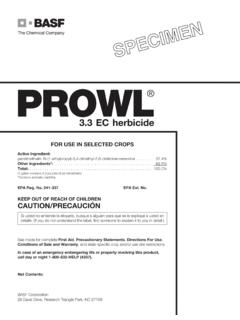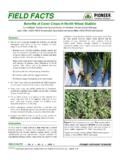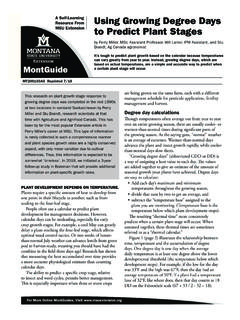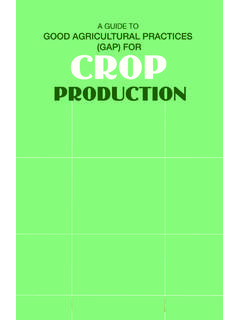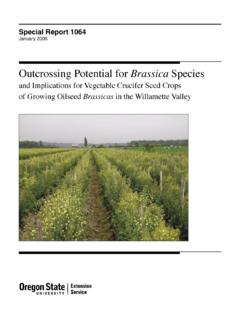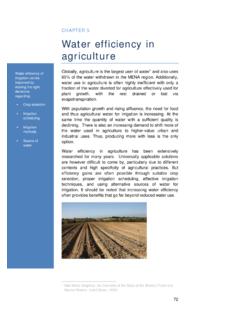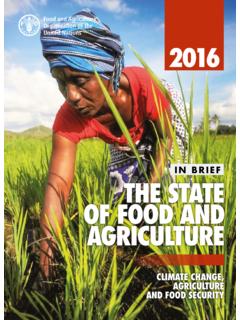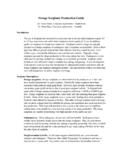Transcription of BIOMASS CO-FIRING WITH COAL AT LAKELAND UTILITIES
1 BIOMASS CO-FIRING WITH COAL AT LAKELAND UTILITIESF inal Report to The United States Department Of EnergyunderContract No. 97 RKW-219287forSeptember 1997 - July 1998submitted toMr. Phillip C. Badger, Contract ManagerSoutheastern Regional BIOMASS ProgramPOB 1010 Mail Stop CEB 3 AMuscle Shoals, AL 35662-1010 July 31, 1998byS. A. SegrestThe Common Purpose Institute, Temple Terrace, FL, 33617, D. L. RockwoodSchool of Forest Resources and Conservation,University of Florida, Gainesville, FL 32611-0410, J. A. StrickerPolk County Cooperative Extension Service,University of Florida,Bartow, FL 33831-9005, and A. E. S. GreenClean Combustion Technology Laboratory,University of Florida,Gainesville, FL 32611-2050 This report was prepared as an account of work sponsored by an agency of the United StatesGovernment. Neither the United States Government nor any agency thereof, nor any of their employees,makes any warranty, express or implied, or assumes any legal liability or responsibility for the accuracy,completeness, or usefulness of any information, apparatus, product, or process disclosed, or that its usewould not infringe privately owned rights.
2 Reference herein to any specific commercial product,process, or service trade name, trademark, manufacturer, or otherwise, does not necessarily constituteor imply its endorsement, recommendation or favoring by the United States Government or any agencythereof. The views and opinions of authors expressed here do not necessarily state or reflect those ofthe United States Government or any agency of AND AND CO-FIRING of Coal and BIOMASS in McIntosh 3 (Option I)..13Co-Firing Issues Specific to II, Low BTU III, Advanced for BIOMASS crop fuel requirements and Project 1. Selected land characterizations (emphasizing timberlands) in counties within a 50-mile radius of LAKELAND (adapted from 6)..38 Appendix 2. Timber quantities on central Florida timberlands by timber class (adapted from6)..38 Appendix 3.
3 Central Florida timberland treatment opportunities by forest type and ownership(adapted from 6)..39 Appendix 4. Summary by soil classification (number and name) of number of parcels and acresof Polk County soils used mainly for pasture within 15, 20, 25, and 30 miles 5a. Leucaena estimated yield, BTU content and establishment 5b. Delivered fuel cost estimates1 for Leucaena with establishment costs amortizedover 10 year life of stand (initial harvest 18 months after establishment then annualharvests)..41 Appendix 6a. Elephantgrass - estimated yield, BTU content and establishment 6b. Delivered fuel cost estimates1 for elephantgrass with establishment costs amortizedover 6 year life of stand (initial harvest 10 to 12 months after establishment then annualharvests)..42 Appendix 7a. Sugarcane presscake (bagasse) 70% of dry-matter crop production is in presscake(30% recovered as sugar).
4 43 Appendix 7b. Delivered fuel cost estimates1 for sugarcane presscake with establishment costsamortized over the life of the stand2 (initial harvest 10 - 12 months after establishmentthen annual harvests)..43 Appendix 8. Risk of freeze or drought effects on net cost per MM BTU of a 10% increase ordecrease in yield (green tons per acre) of leucaena, elephantgrass, and 9. Eucalyptus grandis stem wood and bark energywood assumptions for central andsouth 10. Coppice rotation1 delivered fuel cost estimates for Eucalyptus grandis (based onthree coppice harvests every four years after first harvest at four years afterplanting)..45 Appendix 11. Estimated acreage requirement for 2% cofiring of McIntosh-3 with Eucalyptusgrandis grown at the low productivity 12. Estimated acreage needed to supply 2%, 4%, and 6% CO-FIRING at McIntosh-3 withEucalyptus furnishing 50%, leucaeua 30%, and elephantgrass 20% of 13.
5 BIOMASS Gasifier Contact 14. Evaluation of Gasification and Novel Thermal Processes for the Treatment ofMunicipal Solid 15. Heuristic Envirocycler Waste Disposal with Energy project evaluates the major agricultural, power plant engineering, and business development issuesassociated with energy-crop BIOMASS ( , closed loop ) cofiring with coal at LAKELAND UTILITIES McIntosh-3 unit in Polk County in central Florida. McIntosh-3 (a Babcock and Wilcox pulverized coal(PC), wall fired boiler design) is a large power plant (365 MW) operating as a base load facility ( , ahistorical availability/capacity factor of 80+%). Recognizing the MW size and capacity factor ofMcIntosh-3, achieving a BIOMASS CO-FIRING ratio in the 5 to 6 % range (based on generation) wouldrepresent a sizable renewable energy source of ~20 for BIOMASS cropping is readily available in the LAKELAND vicinity.
6 Some 22% of the land is presentlytimberland, much of which is in need of planting or other improvement. Cropland and pasturelandconstitute nearly 50% of the land base, and the pastureland has a very low opportunity cost. Within PolkCounty alone, 185,000 acres of pastureland occur within 15 miles of marginal and reclaimed lands are suitable for BIOMASS cropping of sugarcane, elephantgrass,leucaena, Eucalyptus, and slash pine. BIOMASS yields vary with species, soil type, and cultural intensity,ranging from as low as 10 green tons/acre/year (tay) for E. grandis with minimal intensity on sandy soils, tay for elephantgrass on overburden sites, 35 tay for leucaena on phosphatic clays, to as much as55 tay for E. grandis when managed intensively on clay lands. Because these yields were estimated fromrelatively small experimental plots, commercial-size plantations, ~ 200/300 acres in size, of the promisingenergy crops are recommended to confirm LAKELAND UTILITIES , a target price for Green Energy based on delivered coal costs plus a 10%premium, is in the 2 per Kwh range, or $2 per MMBTU (using McIntosh s heat rate of about 10,000).
7 Based on estimated yields, costs of establishment, harvesting, and transportation, high yielding cropsgrown on reclaimed clay settling areas, E. grandis and leucaena, meet the target price Case MM BTU Production Costs for Four Energy Crops1 EucalyptusLeucaenaElephantgrassPresscake Establishment$ $ $ $ $ $ $ $ $ $ $ $ Production Cost$ $ $ $ yields of 55, 35, 20, and tay, respectivelyHowever, even with competitive production fuel costs for eucalyptus and leucaena energy crops, theeconomics to support capital investment of a closed loop BIOMASS project are still severely limited. Undercurrent LAKELAND Electric economic assumptions of pricing green energy only at a small premium aboveavoided coal costs ( , no capacity component), direct injection CO-FIRING represents probably the onlyrealistic option. After subtracting estimated energy crop fuel costs from project revenues of ~2 per Kwh,very little income would be left to finance capital requirements needed to co-fire via external , this perspective could change by (1) pricing Green Energy to customers at a premium overtotal electricity costs (instead of only the fuel cost component); and (2) applying federal incentivepayments ( , the Renewable Energy Production Incentive, the Section 45 Tax Credit) to the co-utilization of BIOMASS with coal in a pre-existing PC boiler steam turbine facility can proceedby 1) direct injection CO-FIRING or by 2) indirect CO-FIRING using another thermal processing system andfeeding its gaseous, liquid or solid products into the boiler.
8 Prior direct CO-FIRING studies are listed,including a similar wall fired burner arrangement for CO-FIRING BIOMASS . Currently, there are significantfuel processing related limitations at McIntosh-3 to increasing BIOMASS direct McIntosh-3's limit of 2% RDF CO-FIRING impedes effective direct CO-FIRING of BIOMASS orRDF- BIOMASS combined, five ways of overcoming this limitation are identified. The mechanicalprocessing necessary to feed the BIOMASS through the RDF channel is also considered. For indirectco-firing technologies, lists of six external and two internal gasifier vendors are given along withcomments on performance. A brief discussion of advanced gasifiers for directly firing combustionturbines is given. The Appendix contains an extended BIOMASS gasifier vendor contact list and three tablessummarizing a prior detailed evaluation of municipal solid waste or RDF thermal processors that mightalso be adapted for of potential economic and market incentives for BIOMASS cofiring were performed.
9 Currently,every major Electricity Deregulation Bill in Congress includes a provision for a Renewable Energy PortfolioStandard (REPS). With a REPS, every electric utility would be required to generate minimum percentagesof the electricity sold from Renewable Energy Sources such as wind, solar, or BIOMASS . While proposedlegislation varies, typical minimum levels are 2% of Mwh generation by the year 2000, increasing to 10%by 2010. Also, as electricity markets move toward deregulation, marketing research is consistentlyshowing that a Green Energy Option is a significant factor in determining Customer Choice Decisions. In Pilot Deregulation Programs throughout the , when customers are given an option to choose theirelectricity provider, a significant market share is showing a willingness to pay a premium of about 10%for Green sources of generation.
10 Thus, when deregulation occurs, even if a REPS is not enacted, anElectricity Provider that can not offer renewable energy options to customers may find itself locked outof a significant market segment even if it is the lowest cost coming deregulation of electricity markets, coupled with current and future federal tax credits,pollution allowances, etc., suggests a significant business opportunity. However, without any incentivepayments (e. g., the cent/Kwh Renewable Energy Production Incentive (REPI) available to non-taxableelectric UTILITIES ), only eucalyptus and leucaena have any expected case potential of meeting a targetproduction cost of $ per MM BTU for energy crops to be competitive with coal on fuel cost. Although the REPI Credit is legislated to be available for the first 10 years of a project s operation, thereis no guarantee by Congress to fund the REPI Program in years to come.
